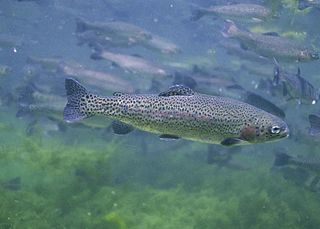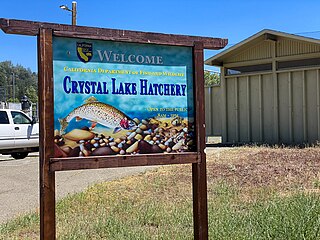The National Fish Hatchery System (NFHS) was established by the U.S. Congress in 1871 through the creation of a U.S. Commissioner for Fish and Fisheries. This system of fish hatcheries is now administered by the Fisheries Program of the U.S. Fish and Wildlife Service (Service), an agency within the United States Department of the Interior.

The rainbow trout is a species of trout native to cold-water tributaries of the Pacific Ocean in Asia and North America. The steelhead is an anadromous (sea-run) form of the coastal rainbow trout(O. m. irideus) or Columbia River redband trout (O. m. gairdneri) that usually returns to freshwater to spawn after living two to three years in the ocean. Freshwater forms that have been introduced into the Great Lakes and migrate into tributaries to spawn are also called steelhead.

The cutthroat trout(Oncorhynchus clarkii) is a fish species of the family Salmonidae native to cold-water tributaries of the Pacific Ocean, Rocky Mountains, and Great Basin in North America. As a member of the genus Oncorhynchus, it is one of the Pacific trout, a group that includes the widely distributed rainbow trout. Cutthroat trout are popular gamefish, especially among anglers who enjoy fly fishing. The common name "cutthroat" refers to the distinctive red coloration on the underside of the lower jaw. The specific name clarkii was given to honor explorer William Clark, coleader of the Lewis and Clark Expedition.

Lake Oroville is a reservoir formed by the Oroville Dam impounding the Feather River, located in Butte County, northern California. The lake is situated 5 miles (8 km) northeast of the city of Oroville, within the Lake Oroville State Recreation Area, in the western foothills of the Sierra Nevada. Known as the second-largest reservoir in California, Lake Oroville is treated as a keystone facility within the California State Water Project by storing water, providing flood control, recreation, freshwater releases to assist in controlling the salinity intrusion into the Sacramento-San Joaquin Delta and protecting fish and wildlife.
Broodstock, or broodfish, are a group of mature individuals used in aquaculture for breeding purposes. Broodstock can be a population of animals maintained in captivity as a source of replacement for, or enhancement of, seed and fry numbers. These are generally kept in ponds or tanks in which environmental conditions such as photoperiod, temperature and pH are controlled. Such populations often undergo conditioning to ensure maximum fry output. Broodstock can also be sourced from wild populations where they are harvested and held in maturation tanks before their seed is collected for grow-out to market size or the juveniles returned to the sea to supplement natural populations. This method, however, is subject to environmental conditions and can be unreliable seasonally, or annually. Broodstock management can improve seed quality and number through enhanced gonadal development and fecundity.

Crystal Lake Fish Hatchery is a fish hatchery run by the California Department of Fish and Game, located in Cassel, California.
The Bellvue-Watson Fish Hatchery is a Colorado Parks and Wildlife cold water fish production facility located near Cache la Poudre River and Watson Lake State Wildlife Area in Larimer County, Colorado. Hatchery staff works to support the raising of approximately 1.5 million sub-catchable trout annually. The Watson Lake Rearing Unit, a division within the hatchery, is responsible for rearing approximately 300,000 catchable trout each year. The hatchery stocks fishing sports in Wellington, Fort Collins, Loveland, Longmont and Jumbo Reservoir near Julesburg and Hale ponds.
The Chalk Cliffs Rearing Unit is a Colorado Parks and Wildlife cold water fish production facility located near Arkansas River and Chalk Creek in Chaffee County, Colorado. Hatchery staff works to support the raising of approximately 700,000 catchable, ten-inch rainbow trout annually. The hatchery stocks fish along the Front Range from Loveland to the New Mexico border, and east almost to the Kansas border.
The Crystal River Hatchery is a Colorado Parks and Wildlife cold-water fish production facility located along the Crystal River in Garfield County, Colorado, near Carbondale. The hatchery raises rainbow trout and Snake River cutthroat trout brood fish. The millions of eggs from these brood fish are shipped to other hatcheries to be raised for stocking.
The Durango Fish Hatchery is a Colorado Parks and Wildlife cold water fish production facility located near the Animas River in Durango, Colorado. The hatchery staff raise rainbow, brown, Snake River and native cutthroat trout, and kokanee salmon.
The Glenwood Springs Hatchery is a Colorado Parks and Wildlife cold water fish production facility located on Mitchell Creek near the Colorado River in Garfield County, which is 2 miles north of West Glenwood Springs.
The John W. Mumma Native Aquatic Species Restoration Facility is a Colorado Parks and Wildlife cold water fish production facility located near Playa Blanca State Wildlife Area and the Rio Grande in Alamosa County.
The Mt. Shavano Hatchery is a Colorado Parks and Wildlife cold-water fish hatchery situated near Arkansas River headwaters at the base of Big Baldy Mountain in Chaffee County. This facility is renowned as one of the largest trout units in the state.
The Pitkin Hatchery is a Colorado Parks and Wildlife cold water fish production facility located in Gunnison National Forest right off of Quartz Creek Valley in Gunnison County.
The Poudre Rearing Unit is a Colorado Parks and Wildlife cold water fish production facility located near Cache la Poudre River at the base of South Bald Mountain in Larimer County. It is considered one of the smaller units in Colorado.
The Pueblo Hatchery is the only Colorado Parks and Wildlife cold and warm water fish production facility located in Lake Pueblo State Park near Arkansas River in Pueblo County.
The Rifle Falls Fish Hatchery is a Colorado Parks and Wildlife cold water fish production facility located off East Rifle Creek near Rifle Falls State Park in Garfield County.
The Roaring Judy Hatchery is a Colorado Parks and Wildlife cold water fish production facility located on East River at the base of Flat Top mountain in Gunnison County. It is home to the largest known kokanee salmon run in the United States.
The Wray Fish Hatchery is a Colorado Parks and Wildlife warm and cold water fish production facility located near Chief Creek and Stalker Lake in Yuma County.





